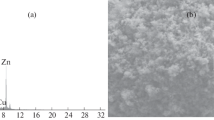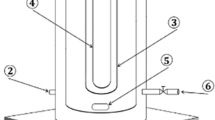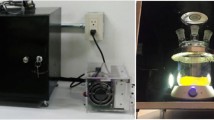Abstract
Photocatalytic degradation of antibiotic rifampicin (RIF) in aqueous solution, employing 100-nm sized anatase TiO2 nanoparticles (NPs) as a catalyst, under 365-nm light irradiation (0.28 mW cm‒2) was investigated. The direct photolysis and adsorptive removal of the ansamycin antibiotic were found to be negligibly inefficient. The experimental data suggest that photocatalysis efficiently degrades RIF, and the effect of irradiation time, catalyst dosage, pH of medium, and temperature was elucidated. The optimum photocatalytic degradation occurred in the colloidal mixture of 30.38 μM RIF solution and 10 mg TiO2 NPs at pH 5.63. The activation energy was estimated to be 1.585 ± 0.079 kJ mol‒1. The photocatalytic degradation kinetics of the antibiotic followed the Langmuir–Hinshelwood model with the rate constant of 0.016 ± 0.002 min‒1, and the additional of a small amount of H2O2 accelerates the photocatalytic process. The degradation pathway was discussed based on vibrational spectroscopic data of RIF and its by-products. Overall, the findings in this study suggest that photocatalysis employing anatase TiO2 NPs under UV light irradiation is a promising approach for the degradation of antibiotics and other pharmaceuticals in wastewater treatment plants.
Graphical abstract






Similar content being viewed by others
References
Moermond CTA, Puhlmann N, Brown AR, Owen SF, Ryan J, Snape J, Venhuis BJ, Kümmerer K (2022) Greener pharmaceuticals for more sustainable healthcare. Environ Sci Technol Lett 9:699–705. https://doi.org/10.1021/acs.estlett.2c00446
Kumar V, Bansal V, Madhavan A, Kumar M, Sindhu R, Awasthi MK, Binod P, Saran S (2022) Active pharmaceutical ingredient (API) chemicals: a critical review of current biotechnological approaches. Bioengineered 13:4309–4327. https://doi.org/10.1080/21655979.2022.2031412
Patel M, Kumar R, Kishor K, Mlsna T, Pittman CU, Mohan D (2019) Pharmaceuticals of emerging concern in aquatic systems: chemistry, occurrence, effects, and removal methods. Chem Rev 119:3510–3673. https://doi.org/10.1021/acs.chemrev.8b00299
Alghamdi BA, Al-Johani I, Al-Shamrani JM, Alshamrani HM, Al-Otaibi BG, Almazmomi K, Yusof NY (2023) Antimicrobial resistance in methicillin-resistant Staphylococcus aureus. Saudi J Biol Sci 30:103604. https://doi.org/10.1016/j.sjbs.2023.103604
Young RJ, Flitsch SL, Grigalunas M, Leeson PD, Quinn RJ, Turner NJ, Waldmann H (2022) The time and place for nature in drug discovery. JACS Au 2:2400–2416. https://doi.org/10.1021/jacsau.2c00415
Kümmerer K (2010) Pharmaceuticals in the environment. Annu Rev Environ Resour 35:57–75. https://doi.org/10.1146/annurev-environ-052809-161223
Khan HK, Rehman MYA, Malik RN (2020) Fate and toxicity of pharmaceuticals in water environment: an insight on their occurrence in South Asia. J Environ Manage 271:111030. https://doi.org/10.1016/j.jenvman.2020.111030
Khan AHA, Barros R (2023) Pharmaceuticals in water: risks to aquatic life and remediation strategies. Hydrobiology 2:395–409. https://doi.org/10.3390/hydrobiology2020026
Helwig K, Niemi L, Stenuick J-Y, Alejandre JC, Pfleger S, Roberts J, Harrower J, Nafo I, Pahl O (2023) Broadening the perspective on reducing pharmaceutical residues in the environment. Environ Toxicol Chem. https://doi.org/10.1002/etc.5563
Frascaroli G, Reid D, Hunter C, Roberts J, Helwig K, Spencer J, Escudero A (2021) Pharmaceuticals in wastewater treatment plants: a systematic review on the substances of greatest concern responsible for the development of antimicrobial resistance. Appl Sci 11:6670. https://doi.org/10.3390/app11156670
Mouele ESM, Tijani JO, Badmus KO, Pereao O, Babajide O, Zhang C, Shao T, Sosnin E, Tarasenko V, Fatoba OO, Laatikainen K, Petrik LF (2021) Removal of pharmaceutical residues from water and wastewater using dielectric barrier discharge methods—aA review. Int J Environ Res Public Health 18:1683. https://doi.org/10.3390/ijerph18041683
Bell KY, Wells MJM, Traexler KA, Pellegrin M-L, Morse A, Bandy J (2010) Emerging pollutants. Water Environ Res 83:1906–1984. https://doi.org/10.2175/106143011X13075599870298
López-Roldán R, de Alda ML, Gros M, Petrovic M, Martín-Alonso J, Barceló D (2010) Advanced monitoring of pharmaceuticals and estrogens in the Llobregat River basin (Spain) by liquid chromatography-triple quadrupole-tandem mass spectrometry in combination with ultra performance liquid chromatography-time of flight-mass spectrometry. Chemosphere 80:1337–1344. https://doi.org/10.1016/j.chemosphere.2010.06.042
Hejna M, Kapuścińska D, Aksmann A (2022) Pharmaceuticals in the aquatic environment: a review on eco-toxicology and the remediation potential of algae. Int J Environ Res Public Health 19:7717. https://doi.org/10.3390/ijerph19137717
Ortúzar M, Esterhuizen M, Olicón-Hernández DR, González-López J, Aranda E (2022) Pharmaceutical pollution in aquatic environments: a concise review of environmental impacts and bioremediation systems. Front Microbiol 13:869332. https://doi.org/10.3389/fmicb.2022.869332
Samal K, Mahapatra S, Ali MH (2022) Pharmaceutical wastewater as emerging contaminants (EC): treatment technologies, impact on environment and human health. Energy Nexus 6:100076. https://doi.org/10.1016/j.nexus.2022.100076
Pindling S, Azulai D, Zheng B, Dahan D, Perron GG (2018) Dysbiosis and early mortality in zebrafish larvae exposed to subclinical concentrations of streptomycin. FEMS Microbiol Lett. https://doi.org/10.1093/femsle/fny188
Porretti M, Arrigo F, Di Bella G, Faggio C (2022) Impact of pharmaceutical products on zebrafish: An effective tool to assess aquatic pollution. Comp Biochem Physiol Part C: Toxicol Pharmacol 261:109439. https://doi.org/10.1016/j.cbpc.2022.109439
Matijević G, Babić S, Maršavelski A, Stipaničev D, Repec S, Čož-Rakovac R, Klobučar G (2023) Estimating risk of cardiovascular pharmaceuticals in freshwaters using zebrafish embryotoxicity test—statins threat revealed. Chemosphere 313:137574–137574. https://doi.org/10.1016/j.chemosphere.2022.137574
Kümmerer K (2001) Drugs in the environment: emission of drugs, diagnostic aids and disinfectants into wastewater by hospitals in relation to other sources—a review. Chemosphere 45:957–969. https://doi.org/10.1016/s0045-6535(01)00144-8
Chaturvedi P, Chaurasia D, Pandey A, Gupta P (2020) Co-occurrence of multidrug resistance, β-lactamase and plasmid mediated AmpC genes in bacteria isolated from River Ganga. Northern India Environ Pollut 267:115502. https://doi.org/10.1016/j.envpol.2020.115502
Ormerod L (1998) Rifampicin and isoniazid prophylactic chemotherapy for tuberculosis. Arch Dis Child 78:169–171. https://doi.org/10.1136/adc.78.2.169
Kulik K, Lenart-Boroń A, Wyrzykowska K (2023) Impact of antibiotic pollution on the bacterial population within surface water with special focus on mountain rivers. Water 15:975. https://doi.org/10.3390/w15050975
Shahrin EWES, Narudin NAH, Shahri NNM, Nur M, Lim J-W, Bilad MR, Mahadi AH, Hobley J, Usman A (2023) A comparative study of adsorption behavior of rifampicin, streptomycin, and ibuprofen contaminants from aqueous solutions onto chitosan: dynamic interactions, kinetics, diffusions, and mechanisms. Emerg Contam 9:100199. https://doi.org/10.1016/j.emcon.2022.100199
Majid AFA, Dewi R, Shahri NNM, Shahrin EWES, Kusrini E, Shamsuddin N, Lim J-W, Thongratkaew S, Faungnawakij K, Usman A (2023) Enhancing adsorption performance of alkali activated kaolinite in the removal of antibiotic rifampicin from aqueous solution. Colloids Surf A: Physicochem Eng Asp 676:132209. https://doi.org/10.1016/j.colsurfa.2023.132209
Singh N, Goldsmith BR (2020) Role of electrocatalysis in the remediation of water pollutants. ACS Catal 10:3365–3371. https://doi.org/10.1021/acscatal.9b04167
Jiménez-Bambague EM, Madera-Parra CA, Rangel-Delgado MF, Quintero-Martinez I, Miranda-Mosquera D, Aristizabal-Apolinar JS, Machuca-Martínez F (2023) Photo-Fenton and electro-Fenton performance for the removal of pharmaceutical compounds in real urban wastewater. Electrochim Acta 442:141905. https://doi.org/10.1016/j.electacta.2023.141905
Kais H, Mezenner NY, Trari M, Madjene F (2019) Photocatalytic degradation of rifampicin: influencing parameters and mechanism. Russ J Phys Chem A 93:2834–2841. https://doi.org/10.1134/s0036024419130119
Madivoli ES, Kareru PG, Makhanu DS, Wandera KS, Maina EG, Wanakai SI, Kimani PK (2020) Synthesis of spherical titanium dioxide microspheres and its application to degrade rifampicin. Environ Nanotechnol Monit Manag 14:100327. https://doi.org/10.1016/j.enmm.2020.100327
Verinda SB, Muniroh M, Yulianto E, Maharani N, Gunawan G, Amalia NF, Hobley J, Usman A, Nur M (2022) Degradation of ciprofloxacin in aqueous solution using ozone microbubbles: spectroscopic, kinetics, and antibacterial analysis. Heliyon 8:e10137. https://doi.org/10.1016/j.heliyon.2022.e10137
Warade AR, Shinde GB, Gaikwad RW, Hakke VS, Sonawane SH, Lingayat A (2023) Intensification of pharmaceutical wastewater treatment using hydrodynamic cavitation process. Mater Today: Proc 77:692–697. https://doi.org/10.1016/j.matpr.2022.11.355
Kurade MB, Mustafa G, Zahid MT, Awasthi MK, Chakankar M, Pollmann K, Khan MA, Park YK, Chang SW, Chung W, Jeon B-H (2023) Integrated phycoremediation and ultrasonic-irradiation treatment (iPUT) for the enhanced removal of pharmaceutical contaminants in wastewater. Chem Eng J 455:140884. https://doi.org/10.1016/j.cej.2022.140884
Deng Y, Zhao R (2015) Advanced oxidation processes (AOPs) in wastewater treatment. Curr Pollut Rep 1:167–176. https://doi.org/10.1007/s40726-015-0015-z
Luttrell T, Halpegamage S, Tao J, Kramer A, Sutter E, Batzill M (2015) Why is anatase a better photocatalyst than rutile? -model studies on epitaxial TiO2 films. Sci Rep 4:4043. https://doi.org/10.1038/srep04043
Janczarek M, Kowalska E (2017) On the origin of enhanced photocatalytic activity of copper-modified titania in the oxidative reaction systems. Catalysts 7:317. https://doi.org/10.3390/CATAL7110317
Suhaimi NAA, Shahri NNM, Samat JH, Kusrini E, Lim J-W, Hobley J, Usman A (2022) Domination of methylene blue over rhodamine B during simultaneous photocatalytic degradation by TiO2 nanoparticles in an aqueous binary solution under UV irradiation. React Kinet Mech Catal 135:511–527. https://doi.org/10.1007/S11144-021-02098-2/METRICS
Sun P, Zhang J, Liu W, Wang Q, Cao W (2018) Modification to L–H kinetics model and its application in the investigation on photodegradation of gaseous benzene by nitrogen-doped TiO2. Catalysts 8:326. https://doi.org/10.3390/catal8080326
Zulmajdi SLN, Zamri NII, Yasin HM, Kusrini E, Hobley J, Usman A (2020) Comparative study on the adsorption, kinetics, and thermodynamics of the photocatalytic degradation of six different synthetic dyes on TiO2 nanoparticles. React Kinet Mech Catal 129:519–534. https://doi.org/10.1007/s11144-019-01701-x
Zulmajdi SLN, Ajak SNFH, Hobley J, Duraman N, Harunsani MH, Yasin HM, Nur M, Usman A (2017) Kinetics of photocatalytic degradation of methylene blue in aqueous dispersions of TiO2 nanoparticles under UV-LED irradiation. Am J Nanomater 5:1–6. https://doi.org/10.12691/ajn-5-1-1
Zeng M (2013) Influence of TiO2 surface properties on water pollution treatment and photocatalytic activity. Bull Korean Chem Soc 34:953. https://doi.org/10.5012/bkcs.2013.34.3.953
Kong CPY, Suhaimi NAA, Shahri NNM, Lim J-W, Nur M, Hobley J, Usman A (2022) Auramine O UV photocatalytic degradation on TiO2 nanoparticles in a heterogeneous aqueous solution. Catalysts 12:975. https://doi.org/10.3390/catal12090975
Suhaimi NAA, Kong CPY, Shahri NNM, Nur M, Hobley J, Usman A (2022) Dynamics of diffusion- and immobilization-limited photocatalytic degradation of dyes by metal oxide nanoparticles in binary or ternary solutions. Catalysts 12:1254. https://doi.org/10.3390/catal12101254
Zamri NII, Zulmajdi SLN, Daud NZA, Mahadi AH, Kusrini E, Usman A (2022) Insight into the adsorption kinetics, mechanism, and thermodynamics of methylene blue from aqueous solution onto pectin-alginate-titania composite microparticles. SN Appl Sci 3:222. https://doi.org/10.1007/s42452-021-04245-9
Gaffuri P, Dedova T, Appert E, Danilson M, Baillard A, Chaix-Pluchery O, Güell F, Oja-Acik I, Consonni V (2022) Enhanced photocatalytic activity of chemically deposited ZnO nanowires using doping and annealing strategies for water remediation. Appl Surf Sci 582:152323. https://doi.org/10.1016/j.apsusc.2021.152323
Hirakawa T, Yawata K, Nosaka Y (2007) Photocatalytic reactivity for O2•− and OH• radical formation in anatase and rutile TiO2 suspension as the effect of H2O2 addition. Appl Catal A: General 325:105–111. https://doi.org/10.1016/j.apcata.2007.03.015
Attri P, Kim YH, Park DH, Park JH, Hong YJ, Uhm HS, Kim K-N, Fridman A, Choi EH (2015) Generation mechanism of hydroxyl radical species and its lifetime prediction during the plasma-initiated ultraviolet (UV) photolysis. Sci Rep 5:9332. https://doi.org/10.1038/srep09332
Saha D, Desipio MM, Hoinkis TJ, Smeltz EJ, Thorpe R, Hensley DK, Fischer-Drowos SG, Chen J (2018) Influence of hydrogen peroxide in enhancing photocatalytic activity of carbon nitride under visible light: An insight into reaction intermediates. J Environ Chem Eng 6:4927–4936. https://doi.org/10.1016/j.jece.2018.07.030
Alves R, da Silva Reis TV, da Silva LCC, Storpírtis S, Mercuri LP, do Rosário Matos J (2010) Thermal behavior and decomposition kinetics of rifampicin polymorphs under isothermal and non-isothermal conditions. Braz J Pharm Sci 46:343–351. https://doi.org/10.1590/S1984-82502010000200022
Stets R, do Amaral B, Schneider JT, de Barros IR, de Liz MV, Ribeiro RR, Nagata N, Peralta-Zamora P (2018) Antituberculosis drugs degradation by UV-based advanced oxidation processes. J Photochem Photobiol A: Chem 353:26–33. https://doi.org/10.1016/j.jphotochem.2017.11.006
Harini G, Syed A, Rahiman MK, Bahkali AH, Elgorban AM, Varma RS, Khan SS (2022) Enhanced photodegradation of rifampicin and co-trimoxazole by ZnO/ZnMn2O4/ZnS-PVA and its genotoxicity studies on Allium cepa. Chemosphere 308:136238. https://doi.org/10.1016/j.chemosphere.2022.136238
Xu Q, Owens G, Chen Z (2020) Adsorption and catalytic reduction of rifampicin in wastewaters using hybrid RGO@Fe/Pd nanoparticles. J Clean Prod 264:121617. https://doi.org/10.1016/j.jclepro.2020.121617
Acknowledgements
JH is grateful to MOST (Taiwan) for Grant No. 111-2222-E-006-007.
Funding
The author(s) received no financial support for the research, authorship, and/or publication of this article.
Author information
Authors and Affiliations
Corresponding author
Ethics declarations
Competing interest
The authors declare that they have no known competing financial interests or personal relationships that could have appeared to influence the work reported in this paper.
Additional information
Publisher's Note
Springer Nature remains neutral with regard to jurisdictional claims in published maps and institutional affiliations.
Supplementary Information
Below is the link to the electronic supplementary material.
Rights and permissions
Springer Nature or its licensor (e.g. a society or other partner) holds exclusive rights to this article under a publishing agreement with the author(s) or other rightsholder(s); author self-archiving of the accepted manuscript version of this article is solely governed by the terms of such publishing agreement and applicable law.
About this article
Cite this article
Suhaimi, N.A.A., Umar, M.K.H., Lau, H.L.H. et al. An insight into the photocatalytic degradation of the antibiotic rifampicin by titanium dioxide nanoparticles in aqueous solution under UV light irradiation. Reac Kinet Mech Cat 137, 1105–1123 (2024). https://doi.org/10.1007/s11144-023-02564-z
Received:
Accepted:
Published:
Issue Date:
DOI: https://doi.org/10.1007/s11144-023-02564-z




